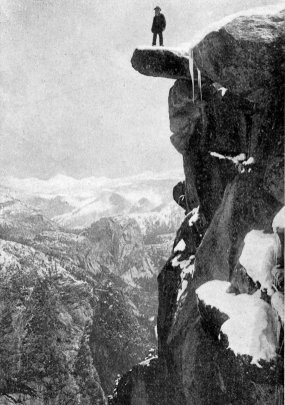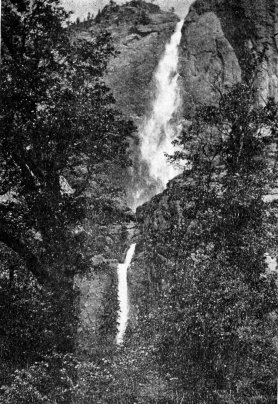
OVERHANGING ROCK, GLACIER POINT
3,250 feet
[Galen Clark standing on Overhanging Rock]
[Photo by George Fiske]
| Online Library: | Title | Author | California | Geology | History | Indians | Muir | Mountaineering | Nature | Management |
Yosemite > Library > Yosemite Valley > History >
Next: Theories Regarding Origin • Contents • Previous: General Characteristics
THE Yosemite Valley was discovered and made known to the public by Major James D. Savage and Capt. John Boling, who, with a strong detachment of mounted volunteers from what was known as the Mariposa Battalion, went with friendly Indian guides to the Valley in March, 1851, to capture the resident tribe of Indians and put them on the Fresno Indian Reservation.
The first improved trail for saddle animals to Yosemite Valley was made by a livery firm in Mariposa, the Mann Brothers, in 1856. This trail led from Mariposa to the Valley by way of the South Fork of the Merced River, crossing the stream at a point now known as Wawona.
In 1857 the regular tourist travel to Yosemite Valley may be said to have commenced, although a few persons had gone there in previous years since its discovery. All parties, at that time, went prepared with camping outfits.
The first house in Yosemite was built in the fall of the year 1856, and was opened the next spring as a saloon for the entertainment of that class of visitors who loved whiskey and gambling. The next year it was fitted up and used as a restaurant. Several years later it was enlarged, and known as Black’s Hotel.
The first building erected for a hotel was built in 1859, and is now a part of the Sentinel Hotel premises, being known as the Cedar Cottage.
Most of the early visitors to Yosemite were Californians, and the number did not amount to one thousand in any one season until the completion of the Union Pacific and Central Pacific Railroads.

OVERHANGING ROCK, GLACIER POINT 3,250 feet [Galen Clark standing on Overhanging Rock] [Photo by George Fiske] |
All the necessary supplies for the hotels and other purposes were taken into the Valley by pack mules from Coulterville and Mariposa, a distance of fifty miles, until the completion of the first wagon roads in 1874.
The main features and great variety of Yosemite scenery were early and widely made known throughout the civilized world by pen, press, and public speech, and have been many times portrayed by paint brush, camera and kodak; but no description, painting or photograph can give its vivid, thrilling, overwhelming life expression.
The officers in command of the military expedition. which discovered Yosemite Valley in 1851, in their report to Governor McDougal, estimated the height of the most prominent parts of the walls around the valley at from twelve hundred to fourteen hundred feet. This is about the height that most visitors estimate them as they see them on entering the Valley. When the actual heights were ascertained by civil engineers, with surveyor’s transit, they were found to be more than double the heights estimated by the unaided eye.
Jarvis Kiel of Mariposa was the first engineer to make some of the actual heights known. He was followed by Prof. J. D. Whitney, State Geologist, with his assistant engineers. Still later came Capt. Wheeler and Lieut. McComb of the United States Engineering Department. There is very little variation in all these reported heights.

YOSEMITE FALLS 2,634 feet [Photo by George Fiske] |
Next: Theories Regarding Origin • Contents • Previous: General Characteristics
| Online Library: | Title | Author | California | Geology | History | Indians | Muir | Mountaineering | Nature | Management |
http://www.yosemite.ca.us/library/the_yosemite_valley/history.html